Stuff White People Like
Litchfield (Google Maps location)
October 3, 2009
Yet again, I’m forced to remind anyone reading this that there are plenty of things to do in Connecticut, year-round – and with kids. When people think of Litchfield, they almost universally think of the town green, the beautiful church there, the top-quality restaurants, Kevin Bacon and colonial history. But there are enough cool places in Litchfield to spend an entire weekend with your family – or alone as the case may be. Heck, make that two weekends, for you could spend an entire day at the White Memorial Conservation Center.
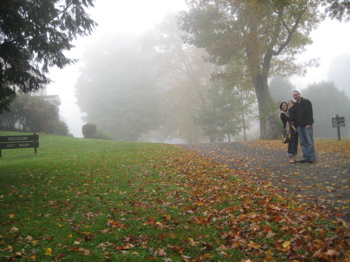
The fairly large and excellent natural history museum is but a small part of the property. A property, like so many others in Litchfield County, which was preserved and donated by Alain C. White and his sister May. If you enjoy a state park or land trust or otherwise protected property in the northwest quarter of the state, chances are you have the Whites to thank. And even though I’ve written and visited plenty of places I am thankful to the Whites for, I figure this is as good a page as any to give their story some of the attention it deserves.
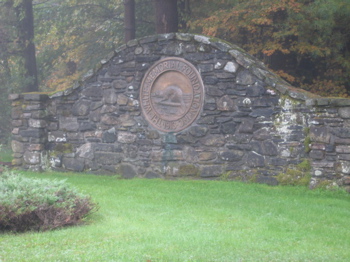
Way back in 1908, Mr. White and his friend, Mr. William Mitchell Van Winkle, were fishing on Bantam Lake (The largest natural lake in Connecticut – CTMQ Visit here) when White said, “Wouldn’t it be wonderful to preserve this river, lake and countryside as we see it now?” (Coincidentally, I’m staring at my “Wild and Scenic Connecticut” calendar given to me by a coworker and the January 2011 picture is of the Bantum (sic) River.)
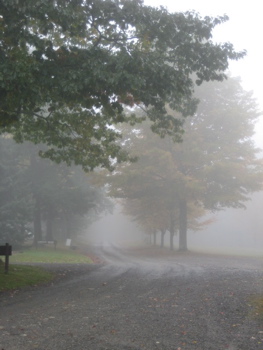
So White did what he thought best – he started to buy up land all around him. The locals were worried that the town would lose a lot of money from taxes so White paid them to make up the shortfall. But he was just getting started; White is considered to be the founder of Connecticut’s State Park system (CTMQ’s list of them here) and was the president of the CFPA from 1923 to 1928 (CTMQ’s attempt to hike every mile of CFPA Trail here). He donated land for parks, such as Mohawk Forest and Mountain State Park in Goshen/Cornwall, Macedonia Brook State Park and Kent Falls (CTMQ’s visit here), both in Kent, and People’s Forest in Barkhamstead (CTMQ’s hike through there, here). On and on…
In 1913, Alain and May White created The White Memorial Foundation in memory of their parents. White Memorial is a 4,000 acre wildlife sanctuary that was created before any state parks existed in Connecticut. I love this guy Alain. He did so many other randomly great things, like…
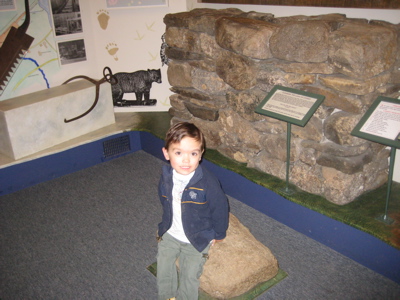
He created many chess problems and he fixed many chess strategies too. He was considered an expert and he published many of his strategies. Lest you think that not so impressive: During World War I, Alain White broke the German Navy code in which chess problems were used. Oh, and in his spare time he played an important part in saving the Wood Duck from extinction. And wrote the history of Litchfield, a publication which is still relevant today.
Mr. Donald Matthews, former Director of the CT State Parks said, “No individual or organization has ever contributed as much to the cause of conservation in Connecticut.” I’m telling you, if you ever go anywhere in or around Litchfield, research the history of the land and chances are the Whites gave it to the state. Campbell Falls State Park in Norfolk (CTMQ Visit), Sunny Brook State Park (CTMQ Visit here)… on and on.

And I’ll deal with the Center’s lands and trails in a separate post someday. At the very least, you should know that the Mattatuck Trail traverses its land and of course I’ll be hiking that someday. For now, let’s focus on the nature museum with its exhibits focusing on the interpretation of local natural history, conservation, and ecology. The Center’s website says:
Exquisite dioramas and spectacular artwork help tell the story of this unique 4,000 acre wildlife refuge – its history and many diverse habitats. Wetlands, fields, old growth forest and upland hardwood forest are depicted with giant photo murals and animal mounts. A special exhibit on the Art of Taxidermy explains how the mounts were made.
A children’s room with books and activities, live snake habitat, beaver dam, fluorescent rock cave, bird sculpture garden, and much more offers a fun and informative experience for the whole family.
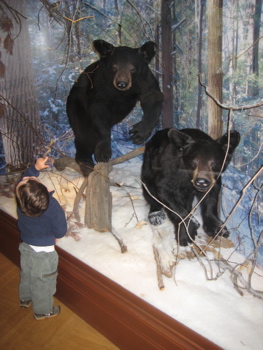
And that’s a great four sentence start. (And really, that should be all you need to get out there to check it out, but this is CTMQ and I must dive a bit deeper.)
Hoang, Damian I made made the drive on one of those murky, clammy October days that – for me anyway – hold a sort of romance. Childhood soccer games, Boy Scout camping trips, football… all those things swirl around in the autumn fog for me. I love them. And what better way to get started than with some Bantam Bread Company dirt bombs? Yes, one of the best baked treats in the state can be had just past the entrance to the conservation center on route 202. (CTMQ’s visit here.) Sufficiently ecstatic, we parked and entered the museum.
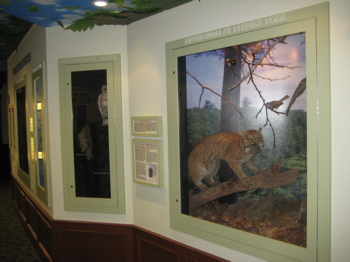
Visitors pay the fee amidst the gift shop wares. I had the idea to take some notes during my visit and had to ask to borrow a pen. You’d have thought I asked the woman to borrow her underwear by the way she looked at me, but in the end, she relented her bic to me. (Not that I really took any useable notes anyway.) As with pretty much ever natural history museum, local wildlife behind glass plays a large role. I say this with love, though, as we can never get enough of bears (See? CTMQ loves bears.)
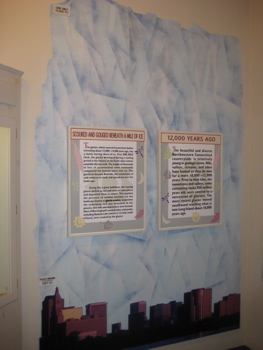
The White Memorial spends a lot of effort telling the story of the geology of the area. I applaud this effort as I happen to think geology is one of those subjects “the kids” just aren’t learning about anymore – and really should be. There’s a cool display showing modern Hartford, Connecticut underneath the mile-thick glacier than covered the area 12-14,000 years ago. There’s the Traveler’s Building, dwarfed by the glacier that scoured out the aforementioned Bantam Lake. It’s appalling that many kids would think this scenario pure fiction.
Don’t ask me why, but Damian felt compelled to kiss the glass holding a stuffed raptor of some sort. Then, as is her way, Hoang followed suit.
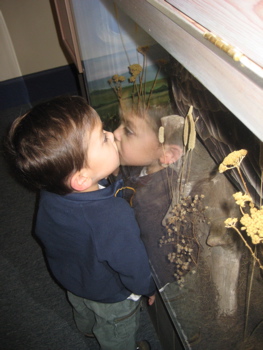
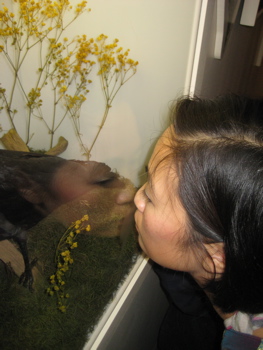
Meanwhile, while those two clowns were goofing around, I chose to actually learn something. The museum has a nice sample of soapstone, available for touching. Now, I’ve hiked through a bunch of former soapstone quarries in Connecticut and beyond, but had never laid my hands on it before. It’s a really unique rock to say the least; it almost feels pliable as you rub it. It does leave a sort of greasy film too, but that may just have been the grime of 400 museum visitors before me, I couldn’t tell.
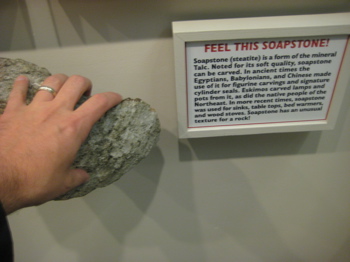
From the geology the exhibits move towards the white man’s arrival. There’s a rather amazing display of the original deed to purchase Litchfield from the Potatucks for the whopping total of fifteen pounds. The best part is the list of Potatuck names on the deed: Chusqunnoag, Quiump, Magnash, Kehow, Sepunkum, Corkscrew, Poni, Wonposet, Suckqunnokqueen, Toweecume, Mansumpansh, and we can’t forget Norkgnotonckquy. Great names… but how the heck did Corkscrew squeak in there? Are we sure he wasn’t some 1956 greaser who, hepped up on goofballs, didn’t deface the document with his own gang given nickname? “Oh hey Suckqunnokqueen, how’re the kids? Good? Me, Quiump and Corkscrew are gonna go hunt some deer, you in?” Nah, there’s no way.
And come to think of it… Poni? As in Poniboy? Where’s Sodapop?
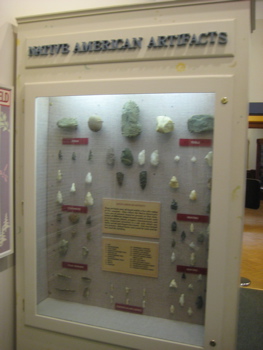
Apparently 15 pounds was one of the more expensive real estate deals of the time, setting the stage perhaps for the current Litchfield County market. Also, the deal wasn’t too awful for the natives as they were able to retain a good chunk of land as a hunting reservation. This area included a hilltop that became known as Mt. Tom, because back in the day natives were all called “Tom.” I’ll have to check, but I think I wondered why Mt. Tom is called Mt. Tom and why there’s another Mt. Tom not too far north in Massachusetts. Now we know. (CTMQ’s swim and hike up to the tower at Mt. Tom State Park.)
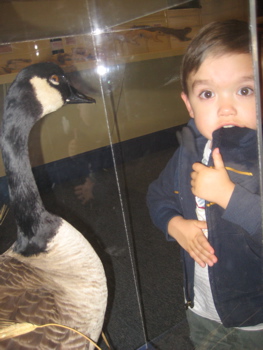
There are the usual native American artifact displays, including a rather impressive arrowhead and implement exhibit. This museum does a really good job of explaining everything you’re looking at; not too wordy but not too dumbed down either. They also employ a really cool panoramic photo technique. In one large display, there’s a nice shot of Bantam Lake in the fall from an “observation deck from Apple Hill” built in the museum. So you walk up some wooden stairs and are transported, in a way, to a hilltop observation deck in the woods. I love that idea and am surprised it’s not used more often around the state.
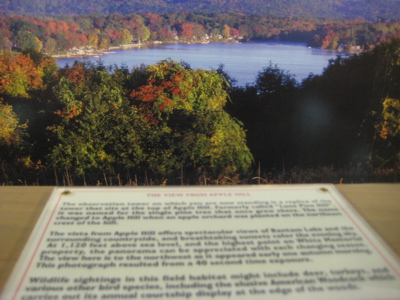
I must admit that I sort of skipped over a lot of the 19th century history displays. You shouldn’t, for they are interesting and rather complete, but as you can guess I’ve seen them all before. Besides, Damian was far more interested in the nature portion of the museum, so that’s where we spent most of our time.
The exhibits here are extensive and impressive. They’ve really spent a good deal of time and effort with these things, as they give a very good ecology lesson to both kids and adults. I was impressed. There are enough things to keep little kids engaged while their parents can take some time to learn about coleopteran and forest succession. But then we turned a corner and saw this:
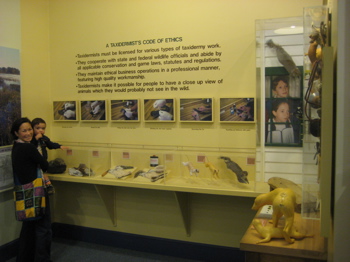
Awesome! A detailed explanation of how all these animals end up in museums. As one who has seen his share of good and bad taxidermy, not to mention several museums with century-old specimens, I found this exhibit wonderful. It’s also wonderfully graphic as well:
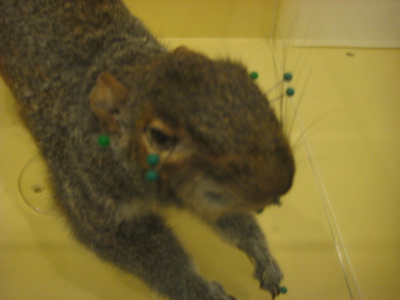
Whoa
Eat it, squirrel. There were a whole host of taxidermist forms and molds and skins and tools on display. It’s a right grizzly job, but when it’s done ethically and beautifully, the results can be amazing. And speaking of grizzly, I don’t remember the display exactly, but here’s a picture of various animal eyes:
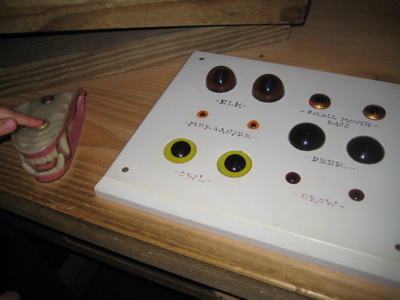
I can only assume the White Memorial Foundation is responsible for more than one kid deciding to major in biology. As one who DID major in biology, I loved this whole area. There is even a wall melding the physics and evolution of birds; showing how and why certain shapes fly high, others flit about at low level, and others walk and swim better. I wish Damian cared to learn about such things, but no, he went outside for a walk in a marsh:
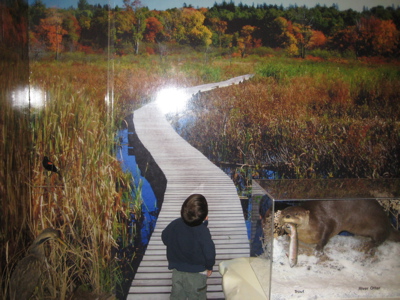
Tricked you! This is another giant photo on a wall and it’s just as cool as the last one. Especially since there’s an otter to the right and a red winged blackbird to the left – two of my all-time favorite Connecticut animals. From there, we were treated to a bunch more animals behind glass. If you enjoy all these ducks and other waterfowl, you should also check out the Livingston Ripley Waterfowl Conservancy just a few miles away (CTMQ Visit here.) All the birds there are alive.
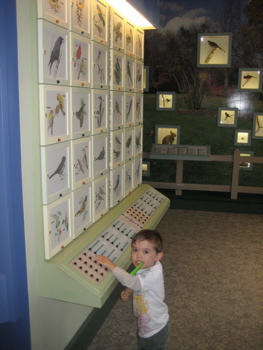
The displays here all seemed to involve the predator/prey relationship. As you probably have guessed, I enjoy that. A bobcat eating a bobwhite. A fox on phlox eating lox. (Okay, a flying squirrel but whatever.) While Damian was cooing about the animals and then adjourning into the fun room set up specifically for little kids, I read some stuff about Catlin Woods. Catlin Woods consists of about 30 acres containing several dozen big white pine and hemlock along with mature hardwoods such as oak, birch and maple. The oldest trees are estimated to be over 200 years old. It’s one of the last remaining (relatively) old grown tracts in the state.
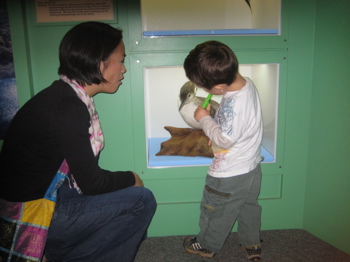
I also checked out another unique display: ceiling silhouettes of nocturnal flying animals. Most birds were more dusk fliers, and flying squirrels don’t really fly but glide. But the best of all was the nighthawk. They are not hawks and they hunt during the day. The silhouettes were overlain constellations. Sort of a two-for-one display.
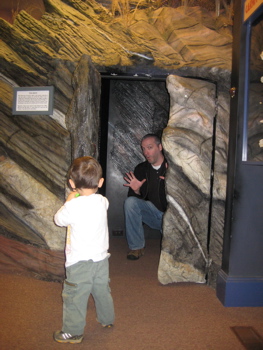
We continued through the one floor museum and found a whole lot more on birds. A massive picture/sound display allows visitors to listen to the various birdsongs. “Flying” stuffed birds hang all over the place and the large picture window gazes across the fields of birdhouses and feeders. Along the walls are more earthy displays about trees and roots and soil and all the creatures that live within them. I was really enjoying the honey bee display, but Damian had moved along to the backyard animals section.
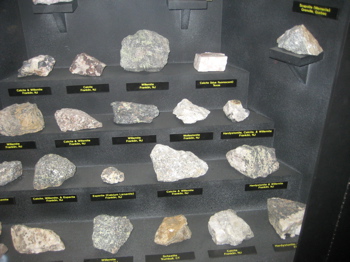
Here, a model house’s deck led down to a yard with information about all the critters we’re apt to see there. Anyway, I recall thinking we were done with the museum but then turned another corner and found another large room with a giant beaver lodge.
You never really appreciate how big these things are until you see something like this… They are huge. Beavers really are among the most amazing mammals on earth. On the other side of the lodge, the structure cleverly transformed into a rock outcrop showing the rock strata of our region – complete with a baying coyote on top. Inside, we found a bunch of mineral samples from the northeast.
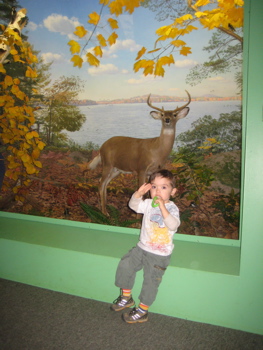
And with that, we came full circle inside the museum. We started out with how our geology came to be and ended with a good exhibit about our present day geology. Well done, White Memorial, well done.
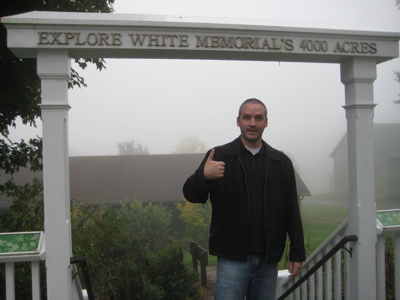
We strolled a small portion of the grounds once back outside. After passing some outdoor cages for (I assume) owls and raptors, we ventured towards the woods. It was dewy and foggy and beautiful. I can’t wait to get back there to do some real hiking someday. And thankfully, a guy named Alain White lived here back in the day. When he was asked in 1938 what he could do with the White Memorial land White said, “The greatest thing we can do for the public is keep this as it is.”
(Just with a cool museum.)
White Memorial Conservation Center

 Peter says
Peter says
February 14, 2011 at 8:33 pmOne thing definitely worth a visit is the actual marsh boardwalk at White Memorial. It must be close to a mile in length and gives you a close-up view of otherwise hard-to-see plant and animal life. Because it’s like it appears in the wall picture, narrow and without handrails, it can be a bit risky with small children, you have to hold their hands at all times.
 fuzzy turtle says
fuzzy turtle says
February 15, 2011 at 12:25 pmwhen I think Litchfield I don’t think of the green or Kevin Bacon.. I think of the VDARE foundation and the ‘Connecticut.National Alliance’ (and not the one on mental illness)
but thanks for the review. I may try and face my fear of Litchfield and venture up to the White Memorial (and hit up the Dutch Epicure Shop while I’m at it!)
love the blog, the kid is adorable
keep up the good work!
 Steve says
Steve says
February 15, 2011 at 1:50 pmHm. I had no idea VDARE had a PO Box (and therefore perhaps an HQ) in Litchfield.
I’m fairly certain they wouldn’t approve of my “cute kid” though, being a “half-breed” and all.
 Peter says
Peter says
February 17, 2011 at 1:49 amPeter Brimelow, the head of VDARE, lives in or near Litchfield, hence the PO box address. I don’t believe there are any actual offices.
 Steve says
Steve says
February 17, 2011 at 9:31 amWow. What a fascinating guy! Born in England, marries a Canadian, moves to the US and writes a bunch of books about how bad immigration is for the US? Then he (in his 60’s) marries a 22 year old Heritage Foundation intern? And VDARE is “rated a white nationalist hate group” by the SPLC?
At least he’s doing his part to keeping Litchfield lily white.